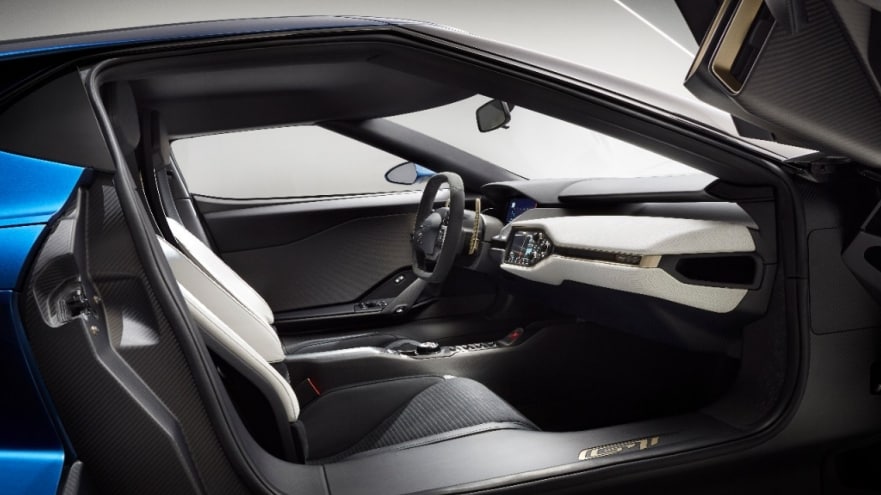- Ford is conducting new research and using high-tech tools – including eye tracking – to collect valuable customer insights from emotional, logical and discovery perspectives
- The same thinking influenced the interior design of the all-new Ford GT supercar, which is based on three principles – clarity of intent, innovation and connection
- Ford GT interior design goes beyond automotive; Ford’s global design studios created several non-automotive design objects, including a racing sailboat that will be on display at leading furniture design event Salone del Mobile, April 14-19, in Milan, Italy
Click here for Ford GT Interior Design Fact Sheet
COLOGNE, Germany, March 19, 2015 – Ford is working with new research and measurement methods and high-tech tools to collect emotional and logical customer insights and learn more about how people visually discover new cars and trucks. New techniques include eye tracking, measuring where eyesight lingers most and biometrics.
“Vehicle interiors have witnessed one of the biggest evolutions across the history of cars in recent years,” said Raj Nair, group vice president, Global Product Development, Ford Motor Company. “Not only have we introduced a great deal of useful new technology into our cars and trucks, we consistently are adding better materials, improved design and increased features across the board, from high-end vehicles to entry-level segments. All of this leads to a focus on design languages that not only convey the right messages, but deliver on an enhanced user experience.”
Research shows that a great-looking interior design can attract new buyers, but if that design isn’t thought through to accommodate different customer needs, this can be a less satisfying experience.
Data collected in Ford’s experimental research is guiding the Ford design team to shape the best customer experience possible.
This is innovation in the design process as well as in the tools used. Research will happen up front, while responses to colour, materials, and any other critical element will continue to be assessed through customer clinics at a later stage of the process.
All-new Ford GT interior design
Ford followed a similar approach in designing the interior of the all-new Ford GT – a two-door supercar that serves as a technology showcase for top EcoBoost performance, aerodynamics and lightweight carbon fibre construction.
First the main components of the Ford GT interior were identified, then the design was pushed forward, introducing new guiding principles and innovative design solutions.
“Over the past few years, we have gained some incredible momentum with our designs,” said Moray Callum, vice president, Design, Ford Motor Company. “As we move forward, we need to build on and evolve what we have achieved so far to continue to deliver exciting and fresh solutions. The interior design of the Ford GT builds on existing DNA and pushes it forward.”
Three guiding principles drive Ford GT interior design:
- Clarity of intent – highlighting focused areas of functionality
- Innovation – pushing the boundaries of innovation to develop new designs and keep changing the way the world moves
- Connection – establishing a connection with the driver through more compact and more intuitive technology
These fundamentals come to life in the Ford GT interior through design solutions that visually communicate:
- Fit for purpose – technology is concentrated and organised in clear islands with an ergonomic logic. All essential functions are within reach without the driver having to move hand position
- Lean and lightweight – the instrument panel features a two-tier step design with floating wing. It makes use of the negative space while calling attention to the edge detailing. The end result is a feeling of spaciousness
- Perceived efficiency – soft materials and hard technology are carefully balanced so that all touchable materials are soft and all technological areas are hard, giving a laser precision read across the instrument panel
Beyond automotive
The thinking behind the interior design of the Ford GT extends beyond the automotive world, serving an inspiration for Ford’s display at this year’s Salone del Mobile. The world’s most prestigious international furniture and design event takes place April 14-19 in Milan, Italy.
Designers across Ford’s global studios applied the new approach to the creation of unique non‑automotive objects that included a racing sailboat, musical instruments, and a football table. Just as with global design review for a vehicle, proposals were vetted by the leadership team to ensure alignment with the fundamentals, feasibility, and efficient use of resources.
“The guidelines developed for the design of the Ford GT interior can lead to very different solutions within and beyond the automotive field,” Callum added. “We opened the challenge to our team to submit proposals for Milan and the response has been overwhelming. Selecting the finalists that will be on display was difficult.”
Click here for Ford GT Interior Design Fact Sheet

